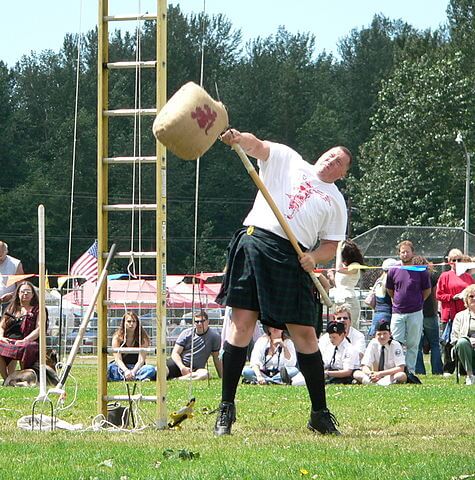Scottish Highland Games
The Scottish Highland Games are an annual spectacle based on strength and athleticism flavored with abundant national pride.
Happening all over Scotland from May until September, they make a fantastic family-friendly day out and there's something for everyone to enjoy.
These games originated in Scotland centuries ago, most likely as a much more serious type of competition designed to find the best warriors, couriers, clan bodyguards and so on.
It's also likely that contests for pipers, dancers and entertainers were involved, to round out the official clan 'staff'.
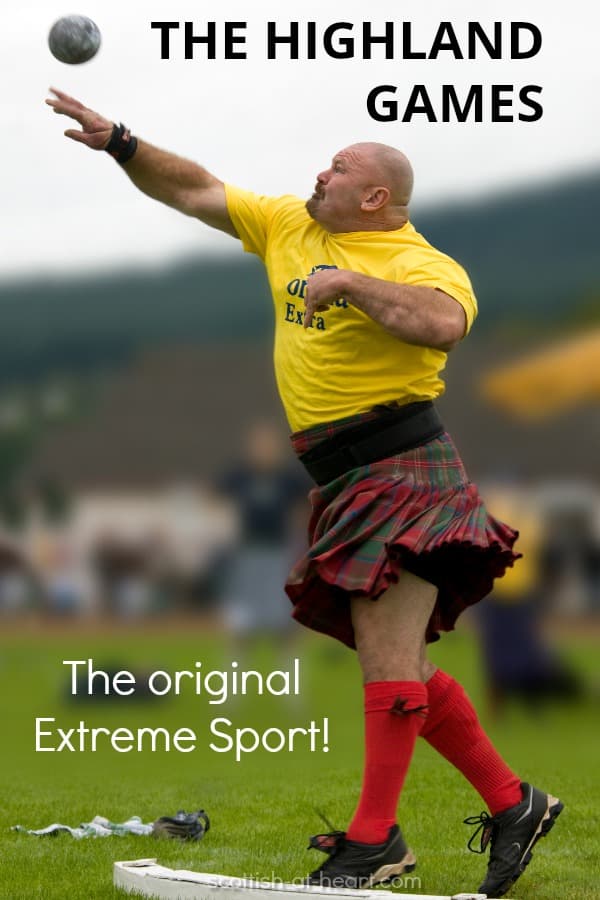
History of Scotlands' Highland Games
Historians aren't certain of the exact reason for the first Highland Games but believe they were used to:
- Find the strongest men for battle
- Find people to fill positions in the clan chieftains' household
These positions most likely included messengers or couriers, bodyguards, pipers, dancers and entertainers.
She first written reference to Highland Games appeared during the reign of Scotlands' King Malcolm III in the 11th century, when he called for men to race to the summit of Craig Choinnich (near the town of Braemar in Aberdeenshire). Historians believe that King Malcolm may have been evaluating the contestants for the role of royal courier.
The Ceres Games in Fife were born in 1314 after Robert the Bruce allowed the village to hold a fair and market in honor of the villagers and clansmen who had fought at the Battle of Bannockburn. These games hold the title of being the oldest, continually active, Highland Games in Scotland.
Ancient Celts Connection
Some of the heavy athletic events are believed to have their roots much further back in history than the organized games themselves, having been used by ancient Celts as tests of strength and stamina as early as the third or fourth century.
In the 18th century, the Laird of Clan Grant summoned clan members, tasking them to bring 'also with gun, sword, pistill and dirk'. This indicates that whatever event they were to attend would involve testing their skill with weapons.
In the mid 18th century the Proscription Acts were put in place by the British Parliament as 'An act for the more effectual disarming the highlands of Scotland; and for restraining the use of the highland dress...'
This act came into effect in 1746 and sought to destroy Highlanders' culture, traditions, customs and way of life and was in place until 1782. During this period any Highland celebrations/traditions that were followed had to be done so in total secrecy, and at great risk.
While prior to 18th century the competition was more war games and less entertainment, as time moved on the contest became less military and more fun with processions and parades, foot races, Highland dance displays, marching pipe bands and vendors of all kinds.
In 1838 Queen Victoria attended the Braemar Highland Games (which are relatively close to Balmoral Castle) for the first time, her royal approval and continuing support led to the games increasing popularity and established them as a Scottish tradition which has continued to grow and expand it's reach and . A tradition which continues today with Queen Elizabeth II and other members of the Royal family attending the Scottish games at Braemar regularly.
The Cowal Highland Gathering in Dunoon, Argyll and Bute, was first held in 1894 and is not considered to be the largest Highland Games in the world. It's also home to the World Highland Dancing Championship which is held in tandem with the games. Thousands of people attend the Cowal Gathering every year and a good time is had by all!
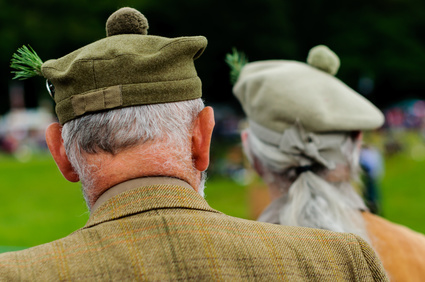
In 1889 the founder of the International Olympic Committee saw some Highland Games events in Paris, and this inspired him to add the Hammer Throw, Shot Put and Tug-O-War to the Olympic Games! Tug-O-War remained an official Olympic events until 1920, and the hammer throwing and shot put contests seen at the Olympics today have their roots in these traditional Scottish games.
Although the games originated as athletic contests, and this is still the main theme today, for centuries they've been one of the biggest social events of the year, especially in the Highlands.
Traditionally they're a family-focused occasion, with family members often traveling long distances to attend. Acting as unofficial family reunions. The social aspects of the Scottish Highland Games make for a fun day (or days) out and most everyone enjoys the dancing, singing, eating, drinking and general catching-up as much as they do the actual athletic events.
Although it has always been traditional for event participants (and often visitors too) to wear kilts, in 2013 the Scottish Highland Games Association made it an official ruling that all competitors in Open Heavy Events at Highland Games are required to wear kilts.
Highland Games Most Popular Contests
Today's Scottish Highland Games often include competitions with a modern twist, such as cycling, track events, sheep-dog-trials, marathon races, and even wellie-throwing contests, but the traditional 'heavy events' which have been played for centuries (and are some of the oldest sporting contents in the world) are always a staple, and definitely the most popular events.
The most popular, and iconic, events at Highland Games are usually the Heavy Athletic competitions.
In Scotland, participants in Highland Games usually simply register as an Adult, Youth or Senior.
An inexperienced person can't just enter a Heavy Athletic Event as they are only open to experienced athletes who can demonstrate their ability to handle the weights and equipment safely and properly. Judges have the authority to disqualify any participant that they feel isn't qualified or up to the standard required.
In North American Scottish game events there may be four different categories:
- Amateur (for beginners)
- Professional (usually by invitation only)
- Masters (for those 40 years or older)
- 190 lbs & under (self-explanatory!)
Depending on the rules and regulations of the specific event there may be a fifth category 'Women' or women may be able to enter whichever of the four categories listed above fits them best.
Heavy athletic contests that you will almost always see at Scottish Highland Games include the Caber Toss, the Hammer Throw, the Stone Put and Tug-O-War.
To learn about the rules and regulations, plus see events calendar and more for Highland Games in Scotland, check out the SGHA website.
Toss The Caber
The Caber Toss is probably the most well-known heavy lifting events at Highland Games.
It's a true test of balance, control, technique and sheer strength.
No-one really knows for sure what the origins of this contest are. Some say it started out as a way for Scots to bridge fast-flowing streams or rivers using the materials to hand. Others believe Highlanders would flip huge logs up against castle walls as a way of breaching their defenses during a seige. There are other, even more unlikely possibilities for the invention of the caber toss, but we'll probably never know which (if any) are the truth.
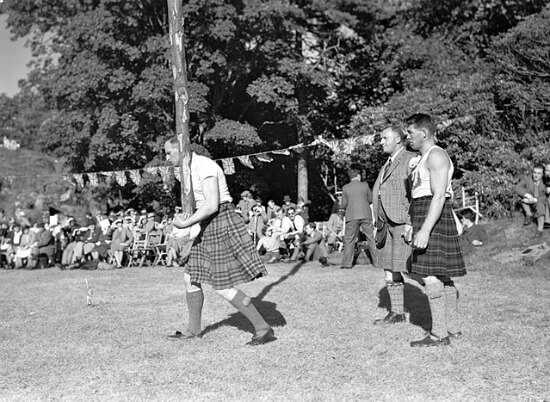 Public Domain Image
Public Domain ImageThe caber is a full-length log, usually between fifteen and twenty-two feet long, and weighing between a hundred and one-hundred-eighty pounds.
The wide variation in lenght/weight is because this length of wood is basically a tree trunk... and tree trunks are not a uniform size! Traditionally local trees are used to make the cabers for Scottish games and either Scots Pine or Larch trees are common choices.
Contestants have to life the caber vertically, cupping the end with both hands (one end of the log is whittled down to a suitable size for this) and then hold it balanced against their body.
Once balanced the thrower has to run a forward for a short distance and use their momentum and upper body strength to literally toss this huge pole into the air, with the aim of sending it end over end in line with the direction of the contestants run.
The top end of the caber should hit the ground first, with the lower end then arcing over it to fall to the ground.
The height and distance that the caber is thrown can look impressive, but judging isn't based on either of those things. Instead it looks for the position the caber comes to rest in.
The aim is to have the caber land directly in front of the contestant, in line with his run.
To make this more clear... picture a clock face on the ground with the caber tosser having taken his throw while standing on the number 6. Ideally, his caber landed on the number 12 with the whittled-down end facing away from him.
Hammer Throw
In keeping with the warlike, militaristic roots of the Scottish Highland Games, the hammer throw may have it's origins as far back in history as the thirteen century as a response to King Edward I of England making it illegal for Scots to own weapons.
The hammer wasn't considered a weapon, but clansmen quickly turned it into one.
In Scottish Highland Games the hammer thrown isn't actually a hammer, but a heavy metal ball which is securely attached to a sturdy four-foot-two-inch pole.
SHGA regulations state that the pole should be made from wood or cane. Standard weight of the hammer (ball) is 22lbs for men, and 16lbs for women (Source: Scottish Highland Games Association regulations)
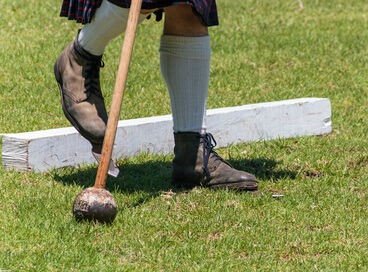
Technique for the Scottish Hammer Throw is fairly simple. Contestants use the pole to swing the hammer around their head and then throw it over their shoulder it as far as they can. Wearing gloves or some type of sticky substance applied to the throwers hands is often recommended, and helps with control.
One main difference from Olympic hammer throwing is that in Scottish games events the hammer thrower has to keep his/her feet firmly planted in one spot and isn't allowed to turn around in a circle the way Olympic contestants are.
Competitors in highland hammer throwing contests often wear special shoes which have flat, metal blades at the front which cut into the ground and help the thrower to maintain his balance and position.
A skilled male competitor can throw the hammer somewhere around 100 to 130 ft, a female competitor between 75 and 100 ft. That's quite a distance! (Source: Highland Games Records)
This clip shows a hammer-throw competitor at the Pitlochry Highland Games. You'll see the blades on the toes of his shoes as he sets himself up for the event.
Stone Put
In Scottish Highland Games, the Stone Put event is similar to the more recognizable Shot Put.
The Scottish term 'Put' means to push, or thrust.
As the name suggests, a heavy stone is thrown rather than a metal ball. Historically these would mostly likely have been large, smooth river rocks which are plentiful in the Highlands.
The stone that men throw should weight between 20 and 26 lbs, for women it's 13 to 18 lbs.
There are two types of Stone Put events, the Braemar Stone and the Open Stone. The main differences are the weight of the stones and the allowable technique.
The Braemar Stone Put requires a stone which weighs between 20 and 26 lbs for men, and 13 to 18 lbs for women. Technique calls for the competitor to throw the stone from a stationary position.
Open Stone Put competitors use a stone which weights between 16 and 22 lbs for men and 8 to 12 lbs for women. The technique employs either 'spin' or 'glide' which are basically two different ways of moving within a designated circle before launching the stone. Both tend to look more like a hop and a shuffle combined. Take a look at this video and you'll see what I mean.
Spin and Glide are used in shot put, and if you're interested in the specifics, check out this page for a very comprehensive look at both techniques.
With the Braemar Stone Put the traditional technique is used which involves cradling the stone in the crook of the neck before launching it from a stationary, standing position. No run up and no spinning. The stone can be thrown with either hand, and in any style.
Judging the Stone Put is simple, whoever throws the stone the farthest is the winner.
If you'd like to get an idea of how far these huge stones can get flung, take a look at this Scottish Masters Athletics Records page which lists the results of a whole host of Highland Games events for a number of years. It's quite eye-opening!
Tug-O-War
Tug-O-War is one of the oldest recorded games in history, even being played in ancient Greece and in China as early 500 - 800 BC. Over the centuries it's been a popular game around the world and was an Olympic event for several years prior to 1920.
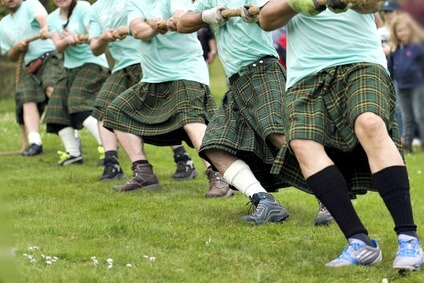
The Tug-O-War event at Highland Games is a simple affair, but it's hugely popular.
All it takes is two teams of eight strong men (some games allow teams of five), a length of sturdy rope and a coach for each team.
Everyone knows how tug-o-war works and the strongest team demonstrates their superiority by dragging the other team across a line which is drawn twelve or thirteen feet from the center (starting point).
The same two teams face off three times to find the winner, and tournaments are approached in a round-robin style.
Tug-O-War is the perfect blend of technique, attitude, adrenaline and brute strength which explains it's popularity at Highland Games not only in Scotland but across the world.
Weight Contests
In addition to the Caber Toss and Hammer Throw, there are several other weight throwing competitions in Highland Games.
These weight contests include Weight Over The Bar (aka Weight for Height), the Weight (For Distance) Throw and the Sheaf Toss.
All of these can games have two categories, 'light weight' and 'heavy weight'.
I've used 'he' in the following info. but both men and women can enter weight events.
Weight Over The Bar
In this contest a weight with attached handle is thrown over a bar whose starting height is determined by the rules of the particular event.
Contestants have to throw with one hand only.
The weight has to be metal, and it has to weigh a specific amount, but it can be any one of a variety of sizes and shapes including round, square, bullet-shaped and more. The handle, which is also allowed to be a number of different shapes including round, u-shaped or triangular, can be attached directly to the weight, or by a length of chain.
The weight-and-chain together can't exceed 18" in length, and are often shorter than this as it can make for an easier throw depending on throwing style.
Each contestant has three tries to get his weight to clear the bar. If he does, he moves on to the next height. If all three attempts are failures he's eliminated.
The weight that is thrown by the men must weigh 56lbs, and for women it must weigh 28lbs. There is often a third category 'Masters' which is for male throwers who are aged forty or older. They can throw either the 56 lbs weight or opt for a 42 lb one instead.
Competitors are allowed individual throwing styles as long as they're judged to be fair and no rules are broken.
Weight For Distance
In Highland Games Weight For Distance competitions regulations for the weight and handle are the same (and equally loose in terms of appearance) as they are for Weight Over bar competitions. This weight-and-handle combo. also can't exceed 18" in length.
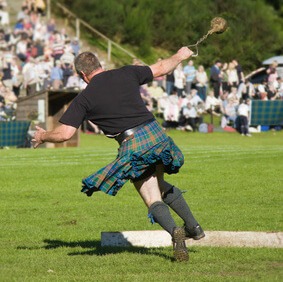
Their are two different sized weights that men can throw, either 28 lbs or 56 lbs, and two for women, either 14 lbs or 28 lbs. If there's a Master Class the weight for that is either 42 lbs or 56 lbs.
Each competitor is allowed three throws (also one-handed as with weight for height contests), the longest throw of the three is the measurement entered for that contestant.
Technique and style for throwing can vary, and as long as the judge rules it to be fair and all regulations are met.
Sheaf Toss
In this event a 'sheaf' is tossed over a bar using a pitchfork.
The origins of this Highland Games event are farm-related and early competitors most likely used regular bales of hay.
Today, the 'sheaf' is a bag, often made from burlap/sacking or plastic, which is stuff with wheat, hay, straw, shredded/chopped rope or mulch.
According to rules, the pitchfork (or hay fork) itself must have at least two tines (prongs), three tines is pretty much universally acceptable and most often used. Some game regulatory organizations only allow forks with three tines. Often forks are shared between competitors or there is a 'house fork' available. If you ever want to compete in this event check on the specific rules for your event first.
Men can toss a 20 lbs sheaf, or if they're entered in the Amateur Class they can toss a 16 lbs one. Women can toss a 12 lb sheaf. If there's a Master Class, they can toss either 16 lbs or 20 lbs.
Three attempts are allowed and technique or style is open as long as it's safe, and the competitor doesn't break any rules. The p
The highest toss which clears the bar cleanly wins. The pitchfork must NOT be tossed!
Scottish Highland Games Music & Dance
One of the highlights of any visit to Scottish Highland Games are the pipers, bands and dancers.
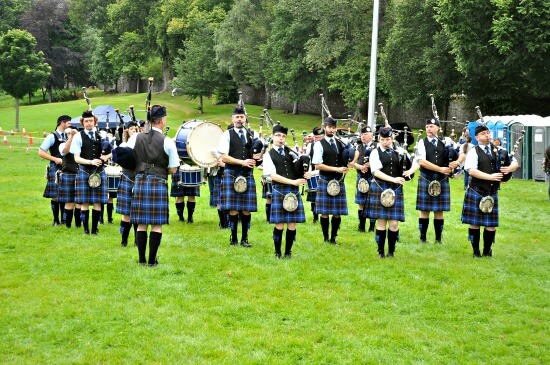
The sound of the bagpipes and drums, and the swirling kilts of the dancers are the heartbeat of the games and stir the blood in a very unique way (Scottish blood for sure, but I have a feeling it does something similar for non-Scots too!).
It's very traditional for the best solo and group dancers to compete for titles and prestige every year at Highland Games. Some travel the world competing in different locations. The Cowal Highland Gathering holds the Scottish National Highland Dancing Championship as well as the World Highland Dancing Championship each year and the spectacle is something you will remember for a very long time!
Piping and drumming contests are held as well as amazing displays of bands playing and marching.
- Home
- Scottish Traditions
- Scottish Highland Games
